Video Marketing for Lawyers
Home » Law Firm Digital Marketing » Video Marketing for Lawyers
Video marketing for lawyers presents many benefits not seen from other digital marketing methods. Video marketing helps capture an audience with compelling content and allows lawyers and law firms to showcase their expertise to prospective clients.
Today, video marketing dominates the digital marketing landscape. The number of people who prefer videos over any other form of content has increased. Videos can also increase user engagement on your website and help your law firm’s SEO.
In this article, you’ll learn why you should add videos to your website and start video marketing campaigns to attract potential clients and grow your law practice. First, let’s look at the types of law firm videos On The Map Marketing creates and some of our production packages.
Type of Law Firm Videos We Create
No matter what practice area you’re in, there’s a legal video that would help you win over new clients. On The Map offers the following video production services to give you the visuals you need for your audience.
- Social media videos
- Explainer videos
- How-to guides and tutorials
- Introduction to your services
- Event announcements
- Q&A Videos
- Client testimonials
- Meet the team/behind-the-scenes videos
- Branded videos
- Company culture videos
- Case studies
- Tutorials
Video Production Packages and Plans for Attorneys
Deciding on a video production process can depend not only on your budget but also logistics and time constraints. This is why On The Map has four different packages to create attorney video marketing content for your firm that is convenient for you.

Video Shoot Half Day
What it includes: Video production for half a day (four hours) including editing for one law firm video
Price: $2,800*
Video Shoot Full Day
What it includes: Video production for a full day (eight hours) including editing for one law firm video
Price: $5,600*
Unlimited Video Monthly Retainer
What it includes: These are flexible packages charged per month and include video marketing options like explainer videos, client testimonials, case studies, and branded videos.
Price: $4,500 per month*
Social Media 30-Second Video
What it includes: In-house produced videos for social media marketing (most specifically YouTube) with a focus on explainer videos, how-to guides, introduction to services, and event announcements.
Price: $1,000 per month*
*Disclaimer: Please note that the prices above are at the time of publishing and are subject to change.
In the next section, let’s look at some top video production companies that your firm can consider.
What is Video Marketing for Lawyers?
Video marketing for lawyers involves using video content in your law firm’s digital marketing strategy. Whether starting a YouTube channel or going on Facebook Live, there are several methods and platforms to carry out video marketing content.
Why Should You Create Video Content for Your Law Firm?
Four key reasons to create videos for your law firm are to:
- Increase conversions and sales
- Increase brand awareness
- Build trust and engagement with prospective clients
- Rank higher in SERPs
Despite the many reasons and benefits of law firm video marketing, you should always focus on generating leads and conversions. Your potential clients may have many questions that can be addressed when they watch videos from your website or social media channels.
8 Simple Steps for Successful Lawyer Video Marketing
Ready to get started with video marketing? Here’s the first step!
Step #1: Set a Goal for Your Video Marketing Campaign
Be clear about what you want to accomplish with your law firm videos. Do you want to educate your viewers on a subject that involves your area of practice? Or do you want to convince potential clients to hire you over the competition?
A goal guides the direction of your video content and allows you to deliver a clear message that makes an impact on prospective clients. It should also be aligned with your overall digital marketing strategy.
Step #2: Conduct Audience Research and Find What Your Prospective Clients Want to See
1. Check competitors and their video content: Watch videos from a rival law firm so you can come up with ideas for your video campaign. Take note of what they did well and what can be improved, applying these notes when creating your videos.
2. Know your audience demographics: Online tools like Facebook Insights and YouTube Analytics can help you find out the location, age, gender, and interests of people who watch and engage in specific videos. You can leverage video data like these to get an idea of your potential clients.
3. Conduct keyword research: Just like finding out what to write on your law firm blog, you should also use keyword research to find topics for video content. Integrating keyword research into your video creation process ensures you’re creating content that people are looking for in search engines.
Step #3: Select the Kind of Video You Want to Produce
Once you’re done with your research, the next step is deciding on the video format or type. There are several types of videos you can create for your law firm.
Here are some common types of videos that law firms create for their campaign:
1. Corporate or branding videos – these videos feature a company or person, what they do, and how they can help the viewer
Our client, Wattel & York, features a video of Atty. David Wattel talks about the firm, how long they’ve been in practice, and how it can help personal injury victims in their cases.
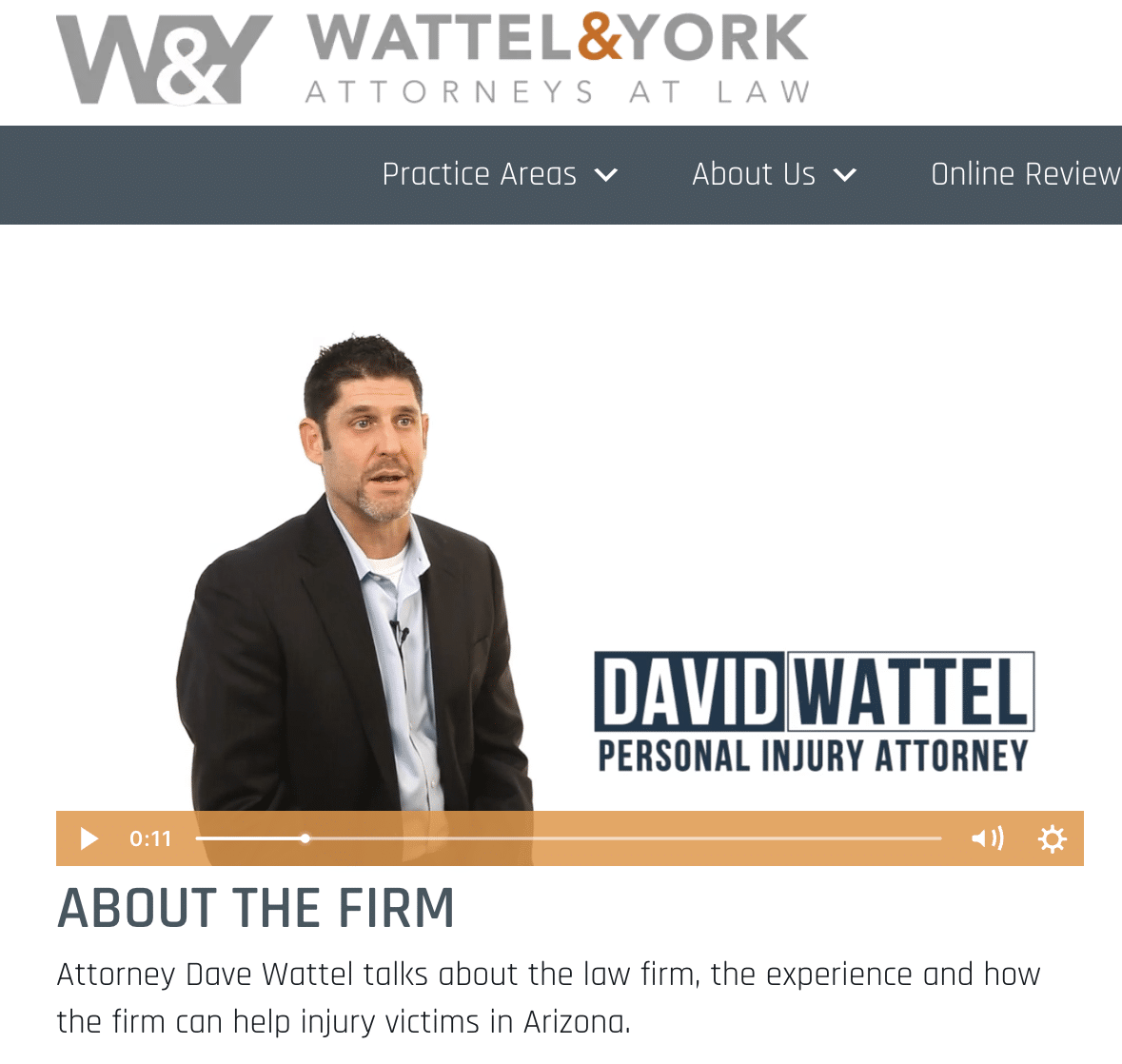
2. Explainer or how to videos – these are videos that teach and explain a certain topic. These videos demonstrate your knowledge in your field while helping educate potential clients about their legal concerns.
Here’s an explainer video from lawyer Brian Galbraith of Galbraith Family Law, where he lists the first ten steps toward separation and divorce:

3. Video testimonials – These videos feature customer testimonials about a service or product and are effective video marketing tools for conversion and getting new clients.
Here’s a client testimonial video from one of our clients, Jesse Minc of Jesse Minc Personal Injury Law:
What Clients Say – Madelyn Coss, Bronx, New York

4. Streaming or live videos – Unlike other video types, streaming videos are broadcasted live and not pre-recorded.
These videos are mostly unscripted, and the speaker can interact with the audience via the video’s comment section. Platforms that have this option include Facebook, TikTok, and Instagram.
Here’s an example of a live video from the Chicago Family Law Group, LLC where the speakers answer a divorce question.
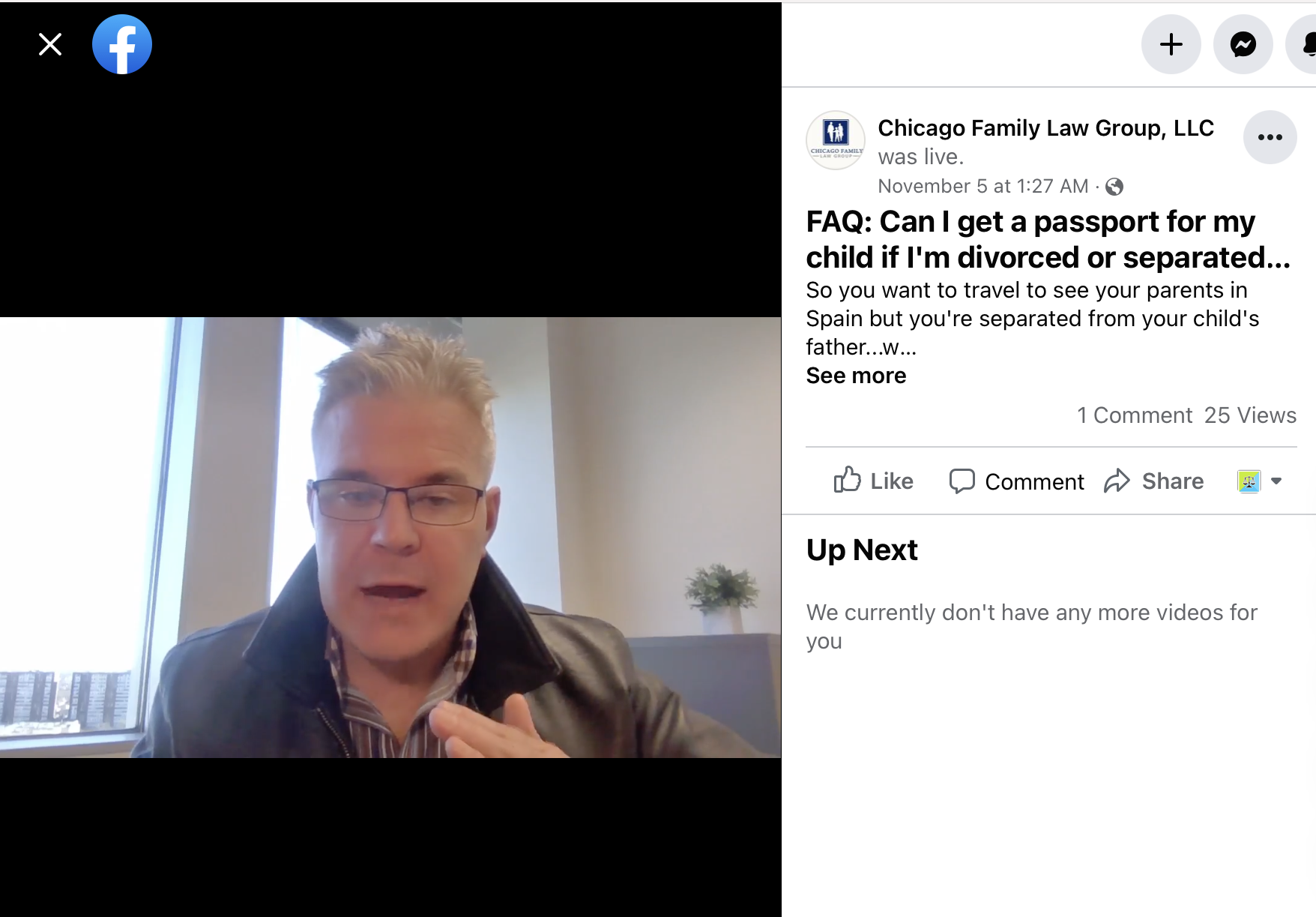
5. Social media videos – These are for social media channels like YouTube, Facebook, and Instagram. These are usually shorter and can sometimes be about current events related to the law firm’s practice.
One of our clients, Greg Kirakosian, published this YouTube short, a commentary on the controversial case between actors Johnny Depp and Amber Heard.
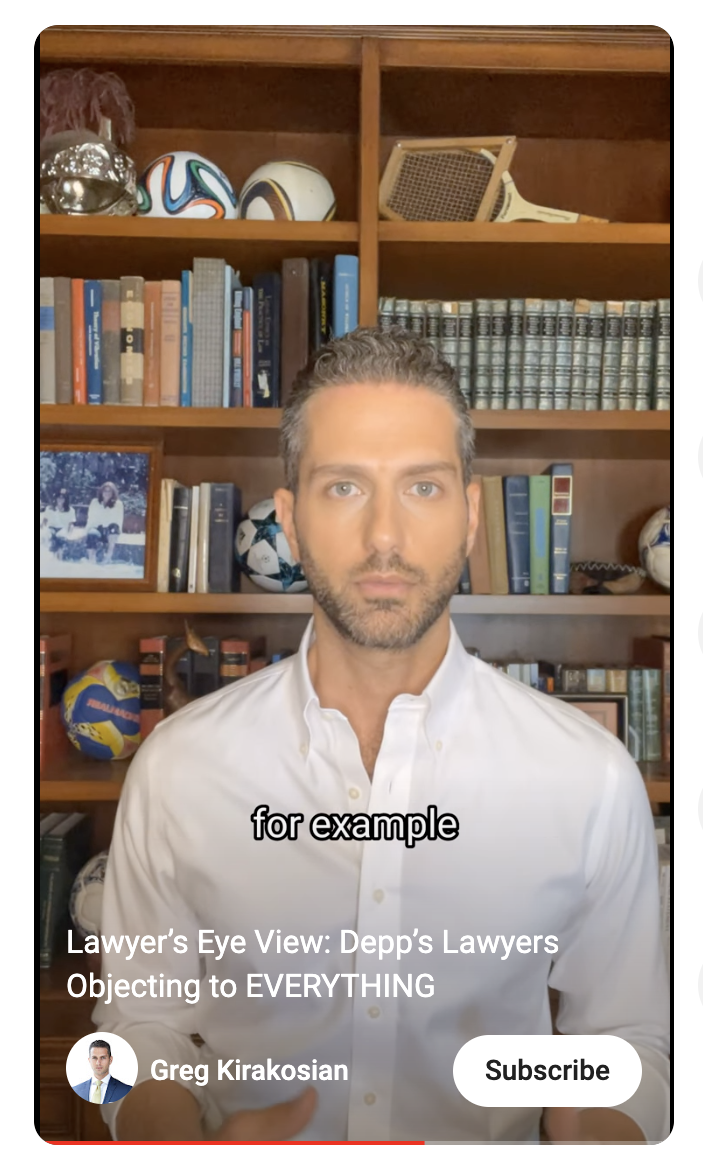
Whichever type of video you want to produce, it should always start with planning and drafting a script.
5. Video ads – These are any kinds of videos that you produce that are shown as an ad on platforms like Facebook, YouTube, and Instagram. Set a target audience for these ads, and it’s a faster way to reach and acquire new clients.
While not an actual advertisement, here’s an example of an ad by Rob Levine & Associates Personal Injury Lawyer.
Step #4: Develop a Video Concept: Write the Script or Storyboard
Before creating law firm videos, you need to have a video concept and write a script. You can outsource this part or do it with your own marketing team.
If you choose to produce the video in-house, here are some tips on writing a law firm video script:
- Identify the goal of your video
Are you informing, educating, or asking your audience to take action? Make sure your script is aligned with your goal
- Write with your target audience in mind
Use words that your prospects will resonate with, address their pain points, and offer a solution
- Read the script out loud and ensure it sounds natural when spoken
Remember that you’re not writing for people to read but for them to hear
- Keep paragraphs short (five sentences at most)
Avoid writing long blocks of text and ensure breaks in between the sentences to help the actor or speaker deliver his lines
- Constantly revise your script and collaborate with other members of your team
Work with other people in your team to identify areas for improvement in your script, and don’t hesitate to make changes as you see fit.
Step #5: Gather Resources to Create Videos
After writing the script, you must list the things and resources needed to produce the video.
Most video production projects require the following:
- Studio or on-site location
- Camera, lights, and other video-making equipment
- The production team (cameraman, director, hair and makeup, set design, production assistants, etc.)
- Talent and talent fees
- Travel expenses
- Shooting Permit
- Post-production (video editing)
If you’re creating the videos yourself, you would need to create a budget and ensure that all these are covered.
On the other hand, outsourcing video production would only require you to pay for the service and wait for the final output.
Step #6: It’s Time to Head Over to Production!
You can proceed with production when you have a final script and all resources ready. Here are some key strategies to help navigate this phase.
Create a schedule for production and set a soft and hard deadline: It’s important to save time and resources during video production, so make a timeline for each part of shooting. A soft deadline allows for any unforeseen delays and a hard deadline to ensure it gets done in a reasonable amount of time.
Track spending and stay on budget: You don’t want to overspend during this part of the video production process, so keep an eye on expenses and check that they’re all within the allotted budget.
Solve problems as quickly as possible: Unforeseen events might affect the progress of your production. While this is normal, you should act decisively and resolve issues as soon as possible to avoid further delays.
Inform your team of any changes in creating the video: If you want to change your video’s concept or creative direction, you need to discuss it with everyone on your team. Allow all team members to air their concerns and address them before moving forward. You should also check that the new approach still aligns with your goals of making the video.
Step #7: Plan a Video Distribution Strategy for Your Law Firm Videos
After production, your video should go through post-production, mainly editing and refining the content. You can hire a law firm video marketing agency to do this team doesn’t have this skill.
The next stage in video marketing is video distribution, which involves putting out your video to the public. In this phase, you get to choose your distribution method and platform.
Here are the most common platforms for publishing videos:
1. Your law firm’s website: Law firms that prefer not to have social media accounts or are in the process of creating one can publish law firm videos on their website. These can be corporate videos, educational videos, or video testimonials with their dedicated page on their attorney sites.
Our client, Wattel & York, uses video as a backdrop for their home page. They also have a dedicated page for all their videos.
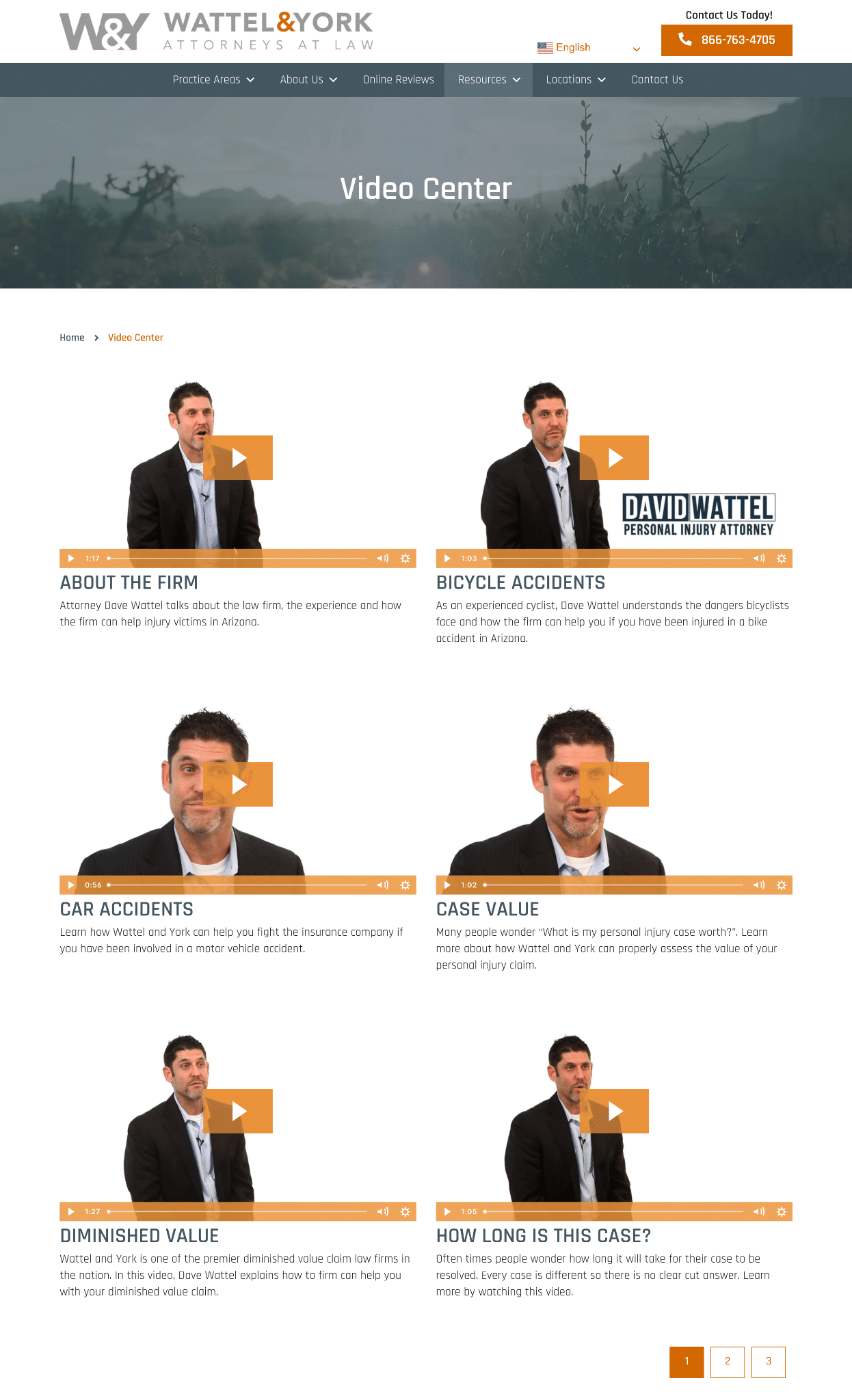
2. YouTube channel
If you plan on publishing YouTube videos regularly, then it makes sense to create a YouTube channel where all your videos are found. YouTube is the world’s largest video platform, with 2.1 billion monthly active users.
In addition to its huge community, YouTube videos can be tracked and measured over time, and you’ll be able to see which videos get the most views and engagement.
Lawyer Terri Herron of Terri Herron Law has a YouTube channel where she shares educational content on family law.
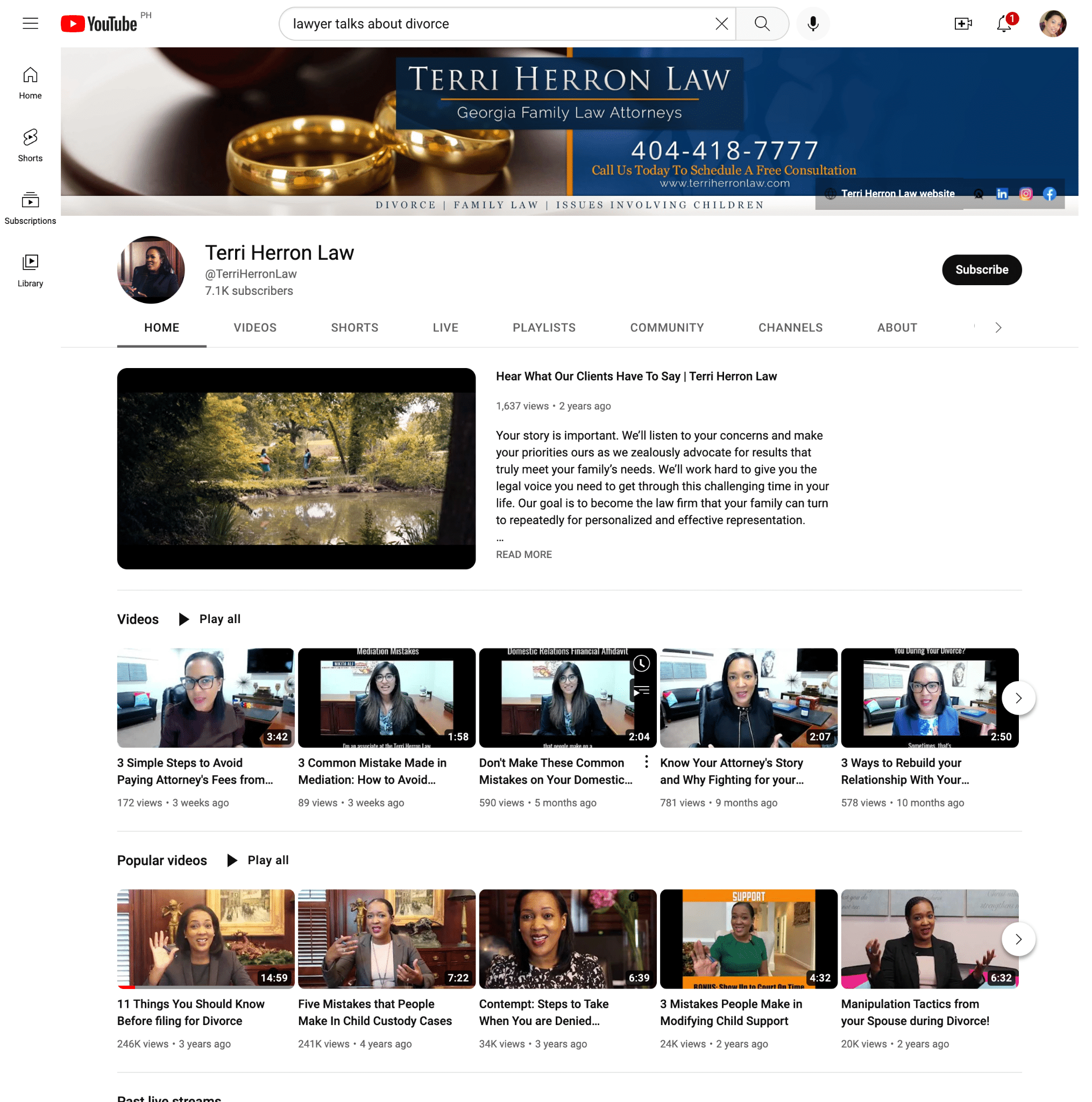
3. YouTube and Facebook ads
For faster results, you can post your video online as an ad on YouTube or Facebook and target your ideal audience.
4. Facebook page
Posting video content on your law firm’s Facebook page is another way to connect with prospects actively using the platform. You can publish one-off videos or broadcast regular Facebook Live sessions, like what the Law Offices of Tragos, Sartes & Tragos do on their Facebook page.

5. Other video-sharing platforms
If you have a younger target audience, you might find more success with Instagram and TikTok.
West Coast Trial Lawyers’ TikTok account is a great example of engaging viewers with short but informative (and funny) video content.
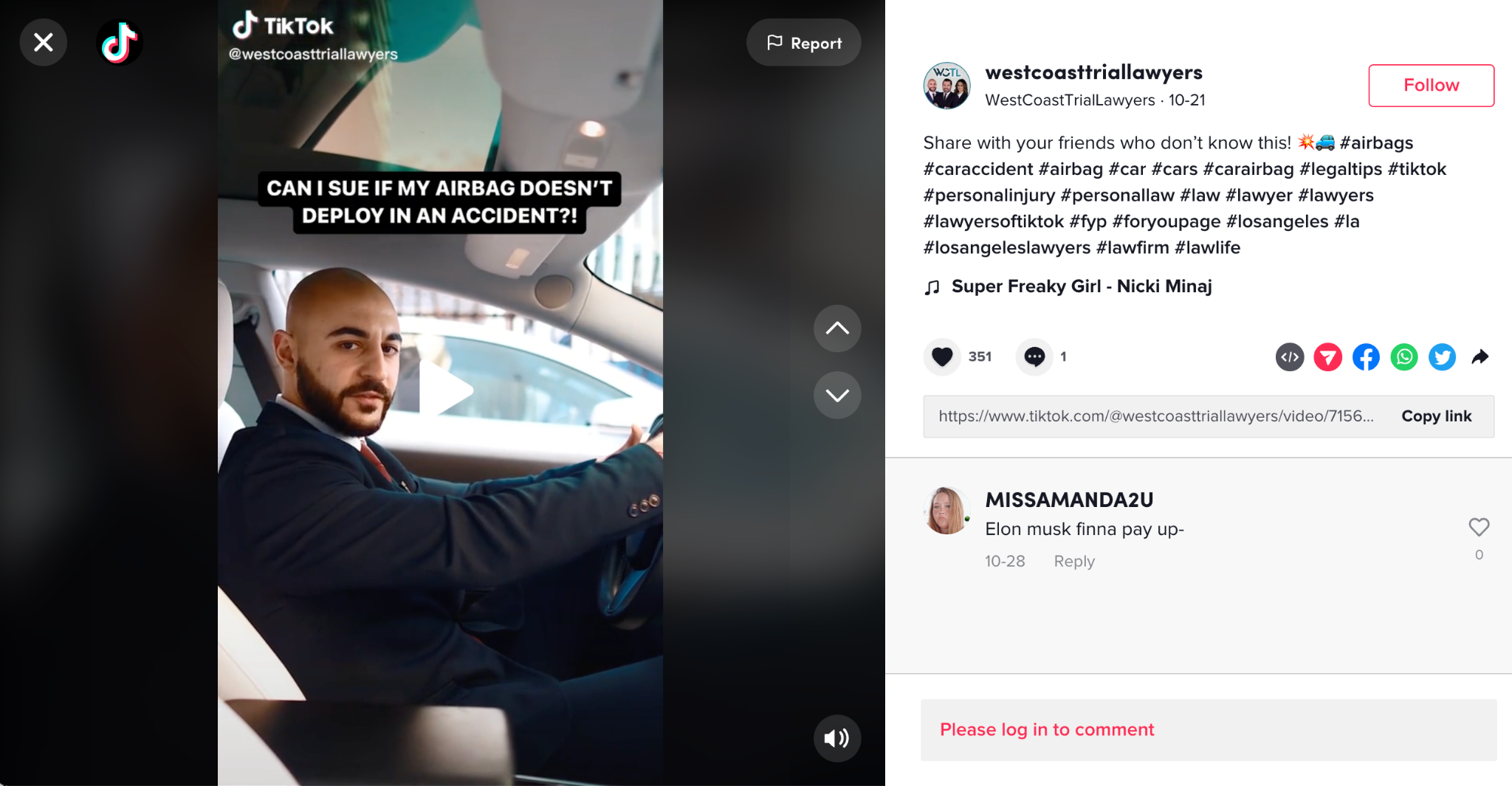
No matter which platform you choose, it’s essential to create a social media marketing strategy to ensure your video content gains views, engagement, and conversions.
A popular method of using video for social media platforms is creating shorter clips from your full-length videos to fit the time limit in most video-sharing platforms. Make sure your messaging is clear and concise in these bite-sized clips.
Step #8: Measure Results and Iterate Your Video Marketing Strategy
You’ll need to track and measure the performance of your videos. Tools like Tubular or YouTube Analytics allow you to see video analytics such as views, engagement, and conversions.
From these metrics, you can find out how many views turned into sales or client calls for your law firm and ultimately measure your return on investment (ROI).
Here’s a quick summary of how to measure video marketing performance and what metrics you should focus on.
4 Common Law Firm Video Marketing Mistakes to Avoid
Now that you know how to start video marketing, here are four common mistakes lawyers conduct in producing their videos that you should avoid.
1. Making lengthy videos
According to a Statista report, the average YouTube video length is 11.7 minutes. Social media experts recommend posting videos under 3 minutes. Based on these, you can opt to make full-length videos not longer than 10 minutes and your social media videos not longer than 3 minutes.
2. Not investing in quality video and audio equipment
You don’t have to spend on the most expensive equipment, but it should meet the standard video format and quality that most websites use.
At the very least, your videos should be recorded in 1080p Full HD resolution, making them crisp and clear when viewing on a high-resolution display.
3. Creating videos that do not have a specific call-to-action (CTA) at the end
A CTA is an important strategy to push your audience to take action. You need to bring your viewer one step closer to becoming your client, and you can do this with a clear CTA at the end of every video.
4. Failure to leverage video content for SEO
YouTube is the world’s second largest search engine. Next to Google, people go to YouTube to learn something or get answers to their questions.
So make video SEO a part of your search engine optimization strategy. Always optimize your videos for SEO so they appear in search results. Include relevant keywords in your video title, meta tags, and description.
Related: YouTube For Lawyers
Let On The Map Marketing Help You Create Engaging Videos That Convert!
You can start video marketing for your law firm yourself. But it’s time consuming and could be difficult to integrate it with your SEO efforts. On The Map Marketing has worked with attorneys for over a decade and would love to help you create engaging video content. Contact us now to get started!
Table of Contents
Related Articles
Dominate Your Market with Digital Marketing Services That Deliver
Talk to a certified professional today, and we will design a strategy specific to your case.






